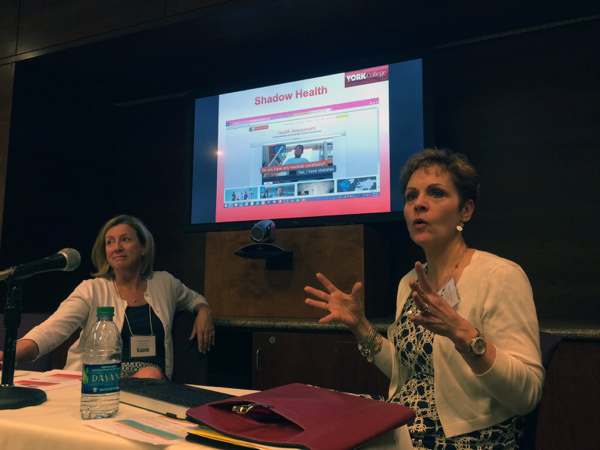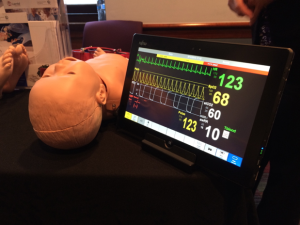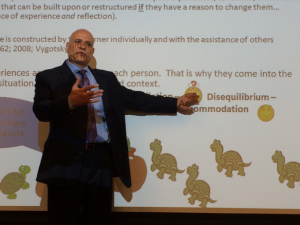
What happens when nurses, armed with simulation technology and innovative learning pedagogies, get together to share how they’ve transformed nursing education at their schools?

A mannequin at a simulation technology vendor booth. These high-fidelity simulators have pulses and injection sites, some can perspire and convulse.
You get a modern, savvy and “culturally competent” workforce that tackles the city’s biggest healthcare problems, like health disparities in underserved populations. That’s the goal of the New York City Nursing Education Consortium in Technology (NYCNECT, pronounced, “N-Y-Connect”), a CUNY-wide network of nurse educators.
This consortium, a five-year, grant-funded project by the U.S. Department of Health and Human Services, trains nurse educators hailing from every nursing school in the City University of New York system on how to incorporate simulation technology into their nursing programs. Hunter College School of Nursing has been the flagship institution for this grant-funded project aimed at helping faculty nurse educators integrate technology into nursing education and practice. This year marked five years, and this June’s meeting was their last. Luckily, I had the opportunity to attend.
Now I say “luckily” for a reason. I used to work in cardiovascular research lab at a heart and lung research institute. I attended over a dozen conferences: covering heart and lung research, medical research, and innovations in research tools.

Knowing the education basics. Keynote speaker Tim Clapper, PhD, an renowned education and simulation consultant, talks about education philosophy and how to keep their technology practical and not distracting, especially for adult learners. “People want learning to be authentic. They want their learning environment to look like what their work environment looks like, “Clapper said.
Even after leaving science for journalism, I roamed my fair share of science, health education, writing and research meetings and forums, mostly for story research. I have learned that these gatherings, more often than not, look the same and are structured similarly. They all have their buzzy room full of posters, attendees chatting in pairs or trios, vendors scanning the room from their booths armed and ready for promotion, and refreshments sitting temptingly in the far corner of the room.
- Focusing on the big picture from the very beginning: NYCNECT Project Manager Shawn McGinniss, kicks off the conference with a message about the importance of teaching nurses well. McGinniss, whose background is in instructional design for health profession training, said that the impact he sees since starting with the project over five years ago, “is inspiring because it doesn’t stop with our students. This work—everything we work very hard for—ends up benefitting our student’s patients and their families.” And seeing as CUNY graduates over half of New York City’s working RNs, this impact stands to transform healthcare in the city.
- Nurses in NYCNECT are always learning. In a room of over 40 nurses, no one seemed dependent on coffee. They’re not just getting introduced, but they’re actively taking lessons throughout the year to become masterful at these methods of instruction.
- For the first time, the keynote speaker isn’t a nurse. Many conferences feature a person from their field. In past years, NYCNECT had done the same, recruiting influential voices in nursing and nursing education, people like Mary Anne Rizzolo, to speak. This year, it was a simulation consultant, Tim Clapper, who gave an engaging talk about teaching methods in health education and how to use technology to advance and not distract learners. His status as a simulation consultant and not a nurse turned out to not be a distraction, either. “Dr. Clapper’s presentation was engaging, interesting and intuitive, I believe every educator would find something to learn and something to apply to their classroom from this speaker,” said nurse Jennifer Louis, an Assistant Professor of Nursing at LaGuardia Community College.
- Nurses are a tight community. In a room full of what organizers call “nurse-transformers,” from over a dozen CUNY institutions with first-time attendees and perennial returners, I walked by two nurses making introductions. “I’ve known you by name for a long time!” said one. It made me realize how much a role NYCNECT plays in peer-to-peer networking.

Nurses from York College talk about their collaboration with Shadow Health, a simulation program used to teach their nursing students how to interact with their patients
- Nurses learn more than tech. The conference is about equipping teaching nurses with more than how-to’s with medical technology tools, McGinniss explains. Tools, he said, do not work without good instruction. “It’s not just teaching with simulation, but to really understand the learning theory and practices behind it that make it useful. Not just tech for the sake of tech. You’re always going to have options for new tools, so if you maintain a solid understanding of pedagogy at play then the tools are just that, tools.”
- The program prides itself on providing CUNY faculty with hands-on instruction in innovative pedagogy and how to integrate healthcare simulation, informatics, and telehealth. But it does more than that. At the end of the day, one nurse got up and thanked the organizers for introducing her to the iPad. Another nurse credited the consortium for influencing her to get “smart” and use a smartphone.
- They want to continue learning and sharing. I expected some cynicism or dismay over lack of funding for future collaboration, but these nurses were intent on keeping the momentum going. A panel of nurses opened up this discussion and most agreed that an annual conference is a must. “We’re talking about a way to form a core group of representatives that would represent all the schools and campuses and identify ongoing needs,” McGinniss said. “It’s all very exploratory.”
This consortium was funded by the Health Resources and Services Administration (HRSA) for the Faculty Development: Integrated Technology into Nursing Education and Practice Initiative (Faculty Development: ITNEP).








